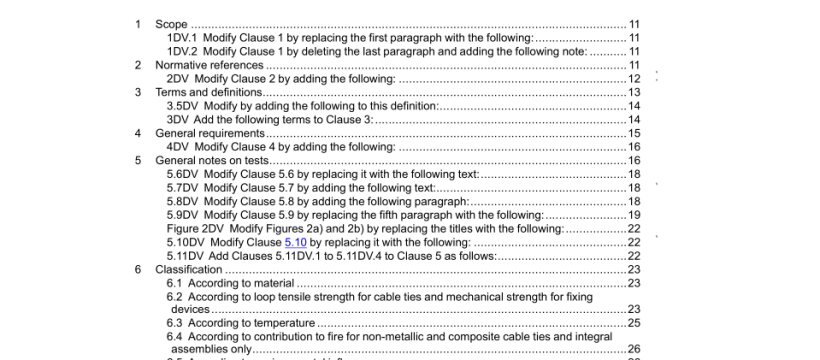UL 62275-2021 pdf download.Cable Management Systems – Cable Ties for Electrical Installations.
3 Terms and definitions For the purposes of this document, the following terms and definitions apply. ISO and IEC maintain terminological databases for use in standardization at the following addresses: • IEC Electropedia: available at http://www.electropedia.org/ • ISO Online browsing platform: available at http://www.iso.org/obp 3.1 cable tie band or length of material, employing a locking device, used for bundling or tying groups of cables together, securing and/or supporting the cables Note 1 to entry: Type 1 and Type 2 cable ties are classified in 6.2.2 and 6.2.3. Note 2 to entry: In some countries, such as Canada and the United States, additional Type classifications are applicable when prequalified moulding materials are used. See UL 62275/CSA C22.2 No. 62275. 3.2 fixing device component (such as a block or bracket) specifically designed to secure the cable tie to a mounting surface 3.3 metallic component component that consists of metal only Note 1 to entry: A metallic cable tie having a thin non-metallic or organic coating, where the coating does not contribute to the determination of the loop tensile strength, is considered a metallic component Note 2 to entry: In case of doubt, “as-received condition” tests with and without coating can be carried out.
5 General notes on tests 5.1 Tests according to this document are type tests. Unless otherwise specified, tests are carried out with the cable ties and their associated fixing devices, where available, installed as in normal use according to the manufacturer’s instructions. Unless otherwise specified, requirements and tests for fixing devices also apply to adhesive fixing devices. NOTE For guidance in determining product types and sample sets, a family of cable ties or fixing devices having material, construction characteristics, and classifications according to Clause 6, in common, are considered of the same product type. Examples for consideration are identical generic material description, material colours, or variable lengths of a cable tie of otherwise similar construction. The sample sets selected for testing from each product type is representative of the extremes of the range (example: shortest and longest), and the minimum performance level obtained for either extreme is determined to be representative of the entire range. Consideration is given to minor construction variations that can be determined by inspection to have no effect on performance, when determining product types. 5.2 Unless otherwise specified, tests on non-metallic and composite components shall commence when the samples have been removed from their packaging and then stabilized at a temperature of (23 ± 5) °C and at a relative humidity of (50 ± 5) %, for a period as indicated in Table 1. NOTE This stabilization intends to achieve equilibrium of moisture content for all samples before and after further conditioning and testing.
5.8 An integral assembly shall be tested as a complete sample. The integral assembly shall be subjected to the conditionings for the cable tie prior to conducting the mechanical strength test for the fixing device in accordance with 9.7. A fixing device, the performance of which is dependent on the mounting hole size, the thickness of the material sheet to which it is to be mounted, or the mounting orientation declared by the manufacturer in accordance with Table 7, shall comply with all applicable tests when the device is assembled to the minimum and maximum thickness of each mounting surface, in the largest hole size, and in each intended mounting orientation declared by the manufacturer. When it can be determined that a particular mounting orientation represents the most onerous condition, the results of the tests in that orientation may represent all mounting orientations. An adhesive fixing device, the performance of which is dependent on the mounting surface or the mounting orientation, shall comply with all applicable tests when the device is assembled on the surfaces for which it is intended, and in each intended mounting orientation declared by the manufacturer. When it can be determined that a mounting orientation represents the most onerous condition, the results of the tests in that orientation may represent all mounting orientations.UL 62275-2021 pdf download.
UL 62275-2021 pdf download
